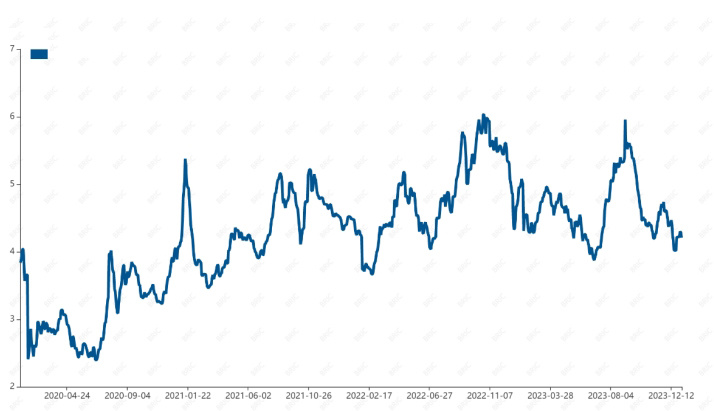09
2024-01
What happened? The egg production rate has recovered to 91%, and the price of eggs has dropped by 13% in just over a month. When will it stop falling?
author:
source:
Feed Industry Information Network
Recently, the spot price of eggs has continued to decline. Taking Hebei, the main production area, as an example, the price of eggs in Handan, Hebei has dropped from 4.47 yuan/jin on December 5th to 3.91 yuan/jin on January 8th, with a cumulative decrease of 13%. Compared with the decrease in 2022, the decrease is relatively low, and the decrease is the same as the same period in 2021. "Mr. Ning, an egg trader in Hebei, said in an interview with Huaxia Times reporter.
Affected by the decline in spot egg prices, the main egg futures contract fell by 9% from November 29, 2023 to January 8, 2024. Compared to the drop in spot egg prices, the drop in futures prices is smaller than the drop in spot prices. As of the close on January 8th, the main egg 2402 contract fell 1.87% on that day, at 3465 yuan/500 kilograms, with a transaction volume of 258 million yuan. Industry insiders say that the decline in egg prices is related to the excessive supply of eggs in recent times.
Egg supply exceeded demand in the fourth quarter of last year
The overall trend of egg prices in 2023 is high in the beginning and low in the end. Before the third quarter, egg prices were running at a high level, reaching a peak of around 5.5 yuan/jin in the peak season, which is at a high level in recent years. However, they quickly fell back after the National Day holiday, and the decline in the off-season was greater than in previous years. This is mainly due to the sharp decline in the food sector at the beginning of the fourth quarter, coupled with the cyclical increase in egg production capacity, which led to an increase in egg supply at the end of the year, "said Song Congzhi, a mid-term analyst at Fangzheng, in an.

(Screenshot source: Brick Agricultural Data Terminal)
Lin Guofa, Director of Big Data Research at Brick Agriculture, also told Huaxia Times that since the Mid Autumn Festival in 2023, the spot price of eggs has been declining, with a small rebound during this period, but the rebound amplitude and duration are relatively short. The price of eggs in early September 2023 was 5.9 yuan/kg, and as of January 8, 2024, the price in egg producing areas across the country has fallen to 4.2 yuan/kg, with a further downward trend.
At the same time, the reporter found that on January 8th, the egg 2403 contract increased its position and fell, closing at 3399 yuan/500 kilograms, a decrease of 2.10%. Recently, egg futures have continuously hit low levels, which is closely related to the decline in spot egg prices and the market's pessimistic expectations for the future. It is understood that the decline in egg prices is related to the low enthusiasm of terminal trade links for receiving goods. At the same time, food companies have limited orders and low procurement volumes, and most of the links focus on clearing inventory. The market circulation is slow, and the trend of inventory growth remains unchanged, putting pressure on egg prices.
The elimination of chickens is still the most critical factor affecting the short-term supply rhythm. The difficulty in eliminating old chickens has led to a relatively small reduction in the supply of large eggs. According to research feedback, this year's consumption has been poor, and most live poultry slaughterhouses have high inventory, resulting in a passive slowdown in the pace of old chicken slaughter. In addition, many farmers still have expectations for egg prices before the New Year. Therefore, it may be difficult to increase the quantity of old chickens before the end of the year, and we will pay attention to the rhythm of chicken elimination around March in the future, "said Cheng, an analyst at CITIC Futures, in an interview with the Huaxia Times.
Egg production rate restored to 91%
Looking back at the development of the industry chain, the egg and poultry breeding industry (broiler and egg laying hens) experienced a wave of capacity expansion from the end of 2018 to 2019, which led to deep losses in poultry in 2020. Egg laying hens continued to suffer deep losses in 2020 until 2021, when breeding profits began to emerge, while white feathered broiler chickens continued to suffer losses until the second half of 2022, "said Lin Guofa.
At the same time, Lin Guofa stated that white feathered broiler chickens are also facing contradictions such as the emergence of avian influenza in some introduced areas abroad and restrictions on introduction. Against this backdrop, the source of broiler chickens is tight, and a large number of laying hens are being converted to 817 meat mixed chickens (seedlings), which to some extent reduces the production capacity of commercial eggs for laying hens. In addition, the breeding end has been facing high feed raw material cost pressure from 2021 to the first half of 2023.
It is understood that corn prices were at a historical high from the end of 2020 to 2022, followed by high soybean meal prices from the end of 2021 to the third quarter of 2023. Under this factor, the high production cost of eggs combined with the conversion of some laying hens to meat and miscellaneous products resulted in high egg prices. It is precisely because of the overall good profit of egg chicken farming that the expansion of egg chicken farming capacity is driven by this factor.
Starting from 2023, domestically produced white feathered broiler chicken breeds have gradually released their production capacity. In the third quarter, the production capacity of white feathered broiler chickens has been well released, reducing the demand for meat offal 817 seedlings. Some laying hens have returned to producing commercial eggs, and a large number of new chickens will be added to the inventory during the September to October period, expanding the production capacity of laying hens and reducing the demand for laying hens to switch to meat offal 817, "said Lin Guofa.
In addition, Cheng, an analyst at CITIC Futures, also stated that from the perspective of spot fundamentals, the sustained decline in spot egg prices is also related to the continuous downward movement of costs. Based on the current prices of feed raw materials (corn, soybean meal), it is estimated that the feed cost per kilogram of eggs is approximately 3.12 yuan/kilogram, a cumulative decrease of 0.3 yuan/kilogram from mid to late October, with a cumulative decrease of 8%. Based on this, the valuation center of spot egg prices continues to decline.
It is worth noting that in terms of egg production rate, the winter temperature is relatively low, and the egg production rate has rebounded to a higher level. According to Zhuochuang Consulting, the peak egg production rate has recovered from the low point of 88.5% at the end of July to 91.86%.
In terms of inventory, due to the high profit margin of egg chicken farming in 2023, the enthusiasm for replenishing inventory has been relatively positive, resulting in a continuous decline in the empty inventory rate of egg chickens. As of the end of 2023, according to Zhuochuang Consulting, the empty inventory rate of egg chickens was only 8.96%, a month on month increase of 0.6% and a year-on-year change of -26%. Cheng also refers to.
Recently, the agricultural product index has shown a systematic decline. On the one hand, egg prices have been dragged down by the sharp drop in upstream feed prices, and on the other hand, they have been affected by the decline in spot prices. After the New Year's Day holiday, there has been a significant short-term decline in consumption, and preparations for the Spring Festival have not yet begun. The center of gravity of egg prices has shifted significantly. However, the overall trading in the futures market is relatively active, with a year-on-year increase of about 20% in trading volume, "said Song Congzhi.
The center of gravity of egg prices continues to shift downwards
The current market has sufficient supply of eggs, with a significant increase in small-sized eggs, confirming an increase in the number of newly produced laying hens. Therefore, the supply of eggs was relatively sufficient before the new year. After experiencing losses in the trade sector, it has also become more cautious, and the overall situation is in a wait-and-see state. There is a slight accumulation of inventory in the intermediate sector, but the absolute quantity is not high, and the overall industry inventory is around one day, "said Song Congzhi.
A certain egg trader in Central China told reporters that egg sales have not been high recently, and the market is currently slow in terms of sales. The overall sales speed of eggs is not fast, and the terminal is mainly based on essential procurement. The market digestion situation is not ideal, and downstream mainly relies on on-demand procurement. In the future, there will be insufficient sales momentum. It is expected that at least by the end of the month, as the Spring Festival approaches, egg prices may rise.
In terms of production and inventory, the number of newly laid laying hens continues to increase. Based on the life cycle of laying hens, the peak number of newly added laying hens in January 2024 is estimated to be the amount of supplementary chicks in July and August 2023, which shows a month on month increase trend. The supplementary chicks have rebounded from the low level, and it is expected that the number of newly added laying hens will gradually increase in the near future. According to data from Zhuochuang Consulting, in December, China's monthly inventory of laying hens was 1.21 billion, a change of 0.25% from the previous month and a year-on-year change of 2.63%.
At the same time, after the New Year's Day holiday, the agricultural product index continued to decline, the spot price of eggs fell, and the valuation center of futures shifted significantly downwards. In terms of egg fundamentals, the current inventory of laying hens continued to rise slightly compared to the previous month, and the elimination of old chickens increased. However, the sales of chicken seedlings in July and August continued to rise compared to the previous month. It is expected that the overall supply of eggs will continue to increase before the Spring Festival in 2024, "said Song Congzhi.
In addition, Song Congzhi stated that the long-term decline in feed raw material prices compared to the previous period may to some extent drag down the center of gravity of egg prices. The current futures price maintains a high discount on spot goods, which largely reflects the expectation of a rebound in production capacity. On the margin, before the Spring Festival, livestock products are collectively moving towards both supply and demand. However, due to the gradual recovery of supply throughout the year, a trend of continuous downward shift in egg prices may have formed, increasing the risk of a downturn in the egg laying industry cycle this year.
Based on the above fundamental analysis, the supply center is gradually rising and the cost center continues to move downwards. We believe that egg prices may mainly fluctuate weakly before the Spring Festival. If there is a strong demand for pre holiday egg stocking, there may be a slight rebound, but even if there is a rebound, the strength is relatively limited. In terms of strategy, it is recommended to focus on the entry opportunities during the short-term rebound of JD2402 and JD2403 at high altitudes, with a lower limit range of 3300-3400.
Lastest Blogs
2024-02-26
Demand for pork falls back after New Year's Eve, hog prices drop sharply this week
According to the monitoring of the Ministry of Agriculture and Rural Development, the average price of pork in the national wholesale
2022-12-07
Biotechnology Turns "Waste" into "Green Feed"
The Application of Biological Feed Helps Develop Unconventional Feed Resources and Reduce Farming Costs
2022-08-16
Biological Functions of Zinc.
Zinc is an essential trace element for the body. In 1933, Todd et al. first reported that zinc was a necessary nutrient for rats. Later
2022-08-16
Overview of the Classification of Trace Element Additives
The feed industry in China began in the 1980s, growing rapidly alongside the country’s economic development.



